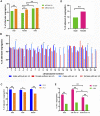Risk Factors Affecting Alternate Segregation in Blastocysts From Preimplantation Genetic Testing Cycles of Autosomal Reciprocal Translocations
- PMID: 35719400
- PMCID: PMC9201810
- DOI: 10.3389/fgene.2022.880208
Risk Factors Affecting Alternate Segregation in Blastocysts From Preimplantation Genetic Testing Cycles of Autosomal Reciprocal Translocations
Abstract
Reciprocal translocations are the most common structural chromosome rearrangements and may be associated with reproductive problems. Therefore, the objective of this study was to analyze factors that can influence meiotic segregation patterns in blastocysts for reciprocal translocation carriers. Segregation patterns of quadrivalents in 10,846 blastocysts from 2,871 preimplantation genetic testing cycles of reciprocal translocation carriers were analyzed. The percentage of normal/balanced blastocysts was 34.3%, and 2:2 segregation was observed in 90.0% of the blastocysts. Increased TAR1 (ratio of translocated segment 1 over the chromosome arm) emerged as an independent protective factor associated with an increase in alternate segregation (p = 0.004). Female sex and involvement of an acrocentric chromosome (Acr-ch) were independent risk factors that reduced alternate segregation proportions (p < 0.001). Notably, a higher TAR1 reduced the proportion of adjacent-1 segregation (p < 0.001); a longer translocated segment and female sex increased the risk of adjacent-2 segregation (p = 0.009 and p < 0.001, respectively). Female sex and involvement of an Acr-ch enhanced the ratio of 3:1 segregation (p < 0.001 and p = 0.012, respectively). In conclusion, autosomal reciprocal translocation carriers have reduced proportions of alternate segregation in blastocysts upon the involvement of an Acr-ch, female sex, and lower TAR1. These results may facilitate more appropriate genetic counseling for couples with autosomal reciprocal translocation regarding their chances of producing normal/balanced blastocysts.
Keywords: PGT-SR; blastocysts; meiotic segregation patterns; next-generation sequencing; reciprocal translocation.
Copyright © 2022 Xie, Hu, Peng, Tan, Luo, Gong, Lu and Lin.
Conflict of interest statement
The authors declare that the research was conducted in the absence of any commercial or financial relationships that could be construed as a potential conflict of interest.
Figures

Similar articles
-
Interaction of acrocentric chromosome involved in translocation and sex of the carrier influences the proportion of alternate segregation in autosomal reciprocal translocations.Hum Reprod. 2019 Feb 1;34(2):380-387. doi: 10.1093/humrep/dey367. Hum Reprod. 2019. PMID: 30576528
-
Analysis of meiotic segregation modes in biopsied blastocysts from preimplantation genetic testing cycles of reciprocal translocations.Mol Cytogenet. 2019 Feb 26;12:11. doi: 10.1186/s13039-019-0423-7. eCollection 2019. Mol Cytogenet. 2019. PMID: 30858883 Free PMC article.
-
Analysis of segregation patterns of quadrivalent structures and the effect on genome stability during meiosis in reciprocal translocation carriers.Hum Reprod. 2018 Apr 1;33(4):757-767. doi: 10.1093/humrep/dey036. Hum Reprod. 2018. PMID: 29579270
-
Successful birth after preimplantation genetic testing for a couple with two different reciprocal translocations and review of the literature.Reprod Biol Endocrinol. 2021 Apr 20;19(1):58. doi: 10.1186/s12958-021-00731-2. Reprod Biol Endocrinol. 2021. PMID: 33879178 Free PMC article.
-
Segregation of chromosomes in sperm of reciprocal translocation carriers: a review.Cytogenet Genome Res. 2005;111(3-4):281-90. doi: 10.1159/000086901. Cytogenet Genome Res. 2005. PMID: 16192706 Review.
Cited by
-
Assessment of quadrivalent characteristics influencing chromosome segregation by analyzing human preimplantation embryos from reciprocal translocation carriers.Comp Cytogenet. 2024 Jan 22;18:1-13. doi: 10.3897/compcytogen.18.115070. eCollection 2024. Comp Cytogenet. 2024. PMID: 38298496 Free PMC article.
-
Sperm Meiotic Segregation Analysis of Reciprocal Translocations Carriers: We Have Bigger FISH to Fry.Int J Mol Sci. 2023 Feb 11;24(4):3664. doi: 10.3390/ijms24043664. Int J Mol Sci. 2023. PMID: 36835074 Free PMC article. Review.
-
Preimplantation genetic testing in couples with balanced chromosome rearrangement: a four-year period real world retrospective cohort study.BMC Pregnancy Childbirth. 2024 Jan 27;24(1):86. doi: 10.1186/s12884-023-06237-6. BMC Pregnancy Childbirth. 2024. PMID: 38280990 Free PMC article.
-
The effect of carrier characteristics and female age on preimplantation genetic testing results of blastocysts from Robertsonian translocation carriers.J Assist Reprod Genet. 2023 Aug;40(8):1995-2002. doi: 10.1007/s10815-023-02853-5. Epub 2023 Jun 20. J Assist Reprod Genet. 2023. PMID: 37338749 Free PMC article.
References
-
- Fatemi N., Varkiani M., Ramezanali F., Babaabasi B., Ghaheri A., Biglari A., et al. (2021). Risk Factors Associated with Recurrent Pregnancy Loss and Outcome of Pre-implantation Genetic Screening of Affected Couples. Int. J. Fertil. Steril 15, 269–274. 10.22074/IJFS.2021.137626.1027 - DOI - PMC - PubMed
LinkOut - more resources
Full Text Sources
Research Materials

